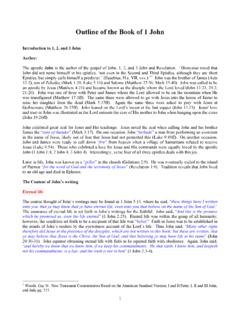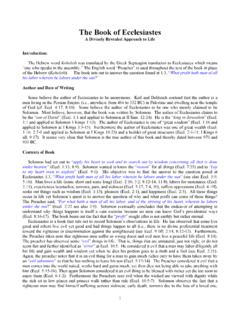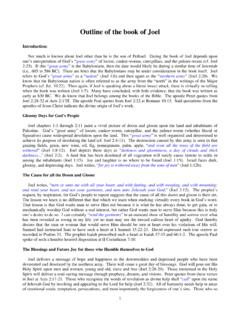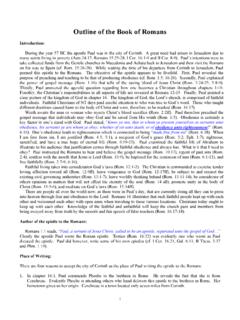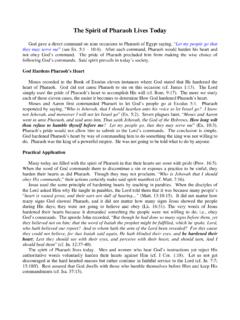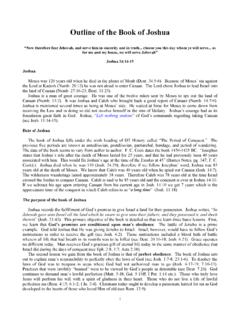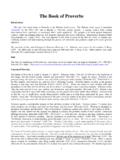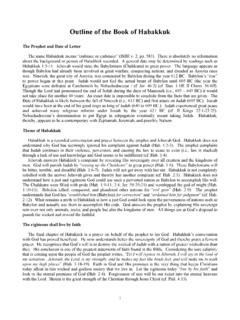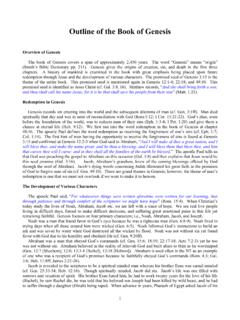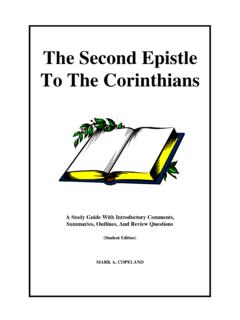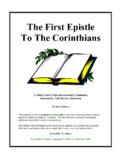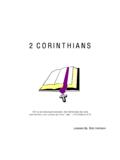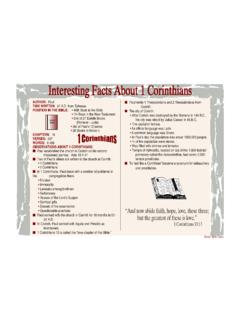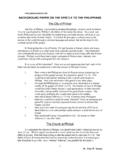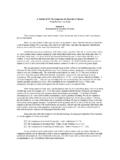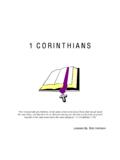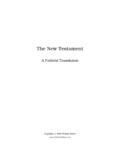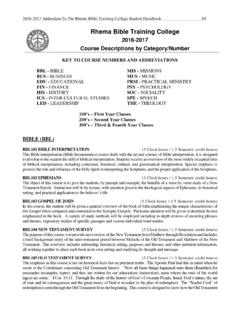Transcription of Outline of the Book of I Corinthians
1 The book of I Corinthians Skeletal Outline of I Corinthians : The Corinthian church remains an example for all times concerning the fact that God does not tolerate sin in His church. The consequence of sin in the body of Christ is disunity (1 Corinthians 1:10). Jealousy and strife are always at the heart of disunity in the church (1 Corinthians 3:3). Spiritual growth is the remedy for any and all problems among brethren, the church, and the home (1 Corinthians 3:1ff). I. A look at the current state of the church (1 Corinthians 1): A. The Corinthian's are the sanctified (1:2) and called (1:2) identified as saints (1:2).
2 B. Paul's charge is that they be unreprovable (1:8). C. Paul beseeches the Corinthians to be united in the word of God (1:10). II. Identifying sins that stood in the way of their being unreprovable (1 Corinthians 1-6): A. Jealousy and strife revolving around measuring self importance by who taught and baptized them (1:12-16; 3:3-4, 21; 4:6). B. Tolerating sin in the church (5:1ff). C. Brethren defrauding each other in the worldly courts (6:1ff). D. Brethren trying to justify their fornication (6:12-20). III. Paul answers the Corinthian's concerns that were apparently put in writing to him (1.)
3 Corinthians 7-10). The brethren were guilty of unlawful divorce, eating meats sacrificed to idols, and fellowshipping sin: A. Concerns about marriage, divorce and remarriage (7:1-40). B. Concerns about eating meats sacrificed idols, the use of one's liberties, and fellowshipping error (chapters 6 - 10). IV. More sinful practices of the Corinthian brethren (1 Corinthians 11): A. 1 Corinthians 11:1-16 exposes their women as being un-submissive. B. 1 Corinthians 11:17ff exposes their ultra-liberal and sinful practices upon the first day of the week assembly by perverting the Lord's Supper.
4 Brethren were having a feast and were drunk with pride upon the first day of the week. C. 1 Corinthians 11:18 expose divisions among the members. V. Errors revolving around spiritual gifts (1 Corinthians 12-14): A. A lack of love for each other caused division in the church over spiritual gifts. Many Corinthians viewed speaking in tongues a greater gift. Paul clears the matter up at 1 Corinthians 14:1-3. B. Chaotic assemblies on the first day of the week; , tongue speakers, prophets, and inspired singers were all speaking and singing at the same time.
5 There was no order in the church (14:26-32). C. Women were addressing the assembly of saints in the church (14:33b 36). VI. False teaching on the resurrection (1 Corinthians 15). A. Paul writes, "How say some among you that there is no resurrection of the dead?". (15:12). B. Paul reasons that if the dead will not be raised then let us eat, drink, and be merry because when we die that would be the end of the matter (yet we know better than this) (15:32). VII. Final Exhortations (1 Corinthians 16): A. Paul reveals his projected itinerary (16:1-12). B.
6 The Corinthians are admonished to stand strong and courageous in the faith (16:13). C. Paul reminds them to remain affectionately connected to each other (16:19-20). 1. Introduction to the book of 1 Corinthians The City of Corinth is located on an isthmus that connects southern Greece to the Peloponnese (Achaia). The connecting isthmus is five miles across. Sailors, coming from Athens or Asia Minor, often stopped in Corinth walking the five miles rather than sailing around the Cape of Malea. Sailing around was, to some extent, a treacherous trip due to the strong Mediterranean winds.
7 Because of the geographic location of Corinth, it was perfect for trade and commerce. Ships, on their way westward, would stop here. Quick population and economic growth was the result. The city of Corinth was a city of great wealth. Wealth and population explosion gave way to an entertainment industry. The Isthmian games were a main source of entertainment to the Corinthians . The games, similar in nature to the Olympic games of neighboring Olympia, occurred every other year. The apostle Paul referred to these games at 1 Corinthians 9:24-27. A city with economic success, vast population, and world renown Olympic style games would naturally attract a variety of religious movements.
8 Most cities of this day were devoted to a particular god or goddess. Ephesus was devoted to the goddess Diana. The principle deity worshipped in the city of Corinth was Venus, the goddess of love and licentiousness. Just to the south of the city was a giant rock formation raising 1800 feet above sea level known as the Acrocorinthus. A temple to Venus was erected on the northern side of this mountain. The temple employed 1000 female prostitutes for the worship of Venus. Barnes notes that many merchants lost everything they had in the city of Corinth worshipping Venus (Barnes' Notes; pp.)
9 Iv [Commentary on I Corinthians to Galatians]). A. common proverb of their day was: It is not for everyone to go to Corinth. The city of Corinth reminds us of our modern day Las Vegas, Nevada. It was the sin city of their day.. The apostle Paul came here around the year 51AD, preaches the gospel of Jesus Christ, and establishes a thriving church (Acts 18:1-4). Paul's visit to Corinth was on his second tour of preaching. He had entered the city alone awaiting the arrival of his traveling companions Timothy and Silas who were to strengthen the churches in Philippi and Thessalonica (Acts 17:10-15).
10 Paul remained in the city of Corinth for about 2 years and then left for Ephesus eventually making it back to Judea (Acts 18:18-19). While Paul was in Corinth, he wrote the epistles to the Galatians and the Thessalonians and upon his second visit he wrote the epistle to the Romans. The epistle to the Corinthians was written by Paul while at the city of Ephesus on his third tour of preaching. 1 Corinthians 16:8-9 states, But I will tarry at Ephesus until Pentecost; for a great door and effectual is opened unto me, and there are many adversaries.. The date was likely AD 55 to 56.
